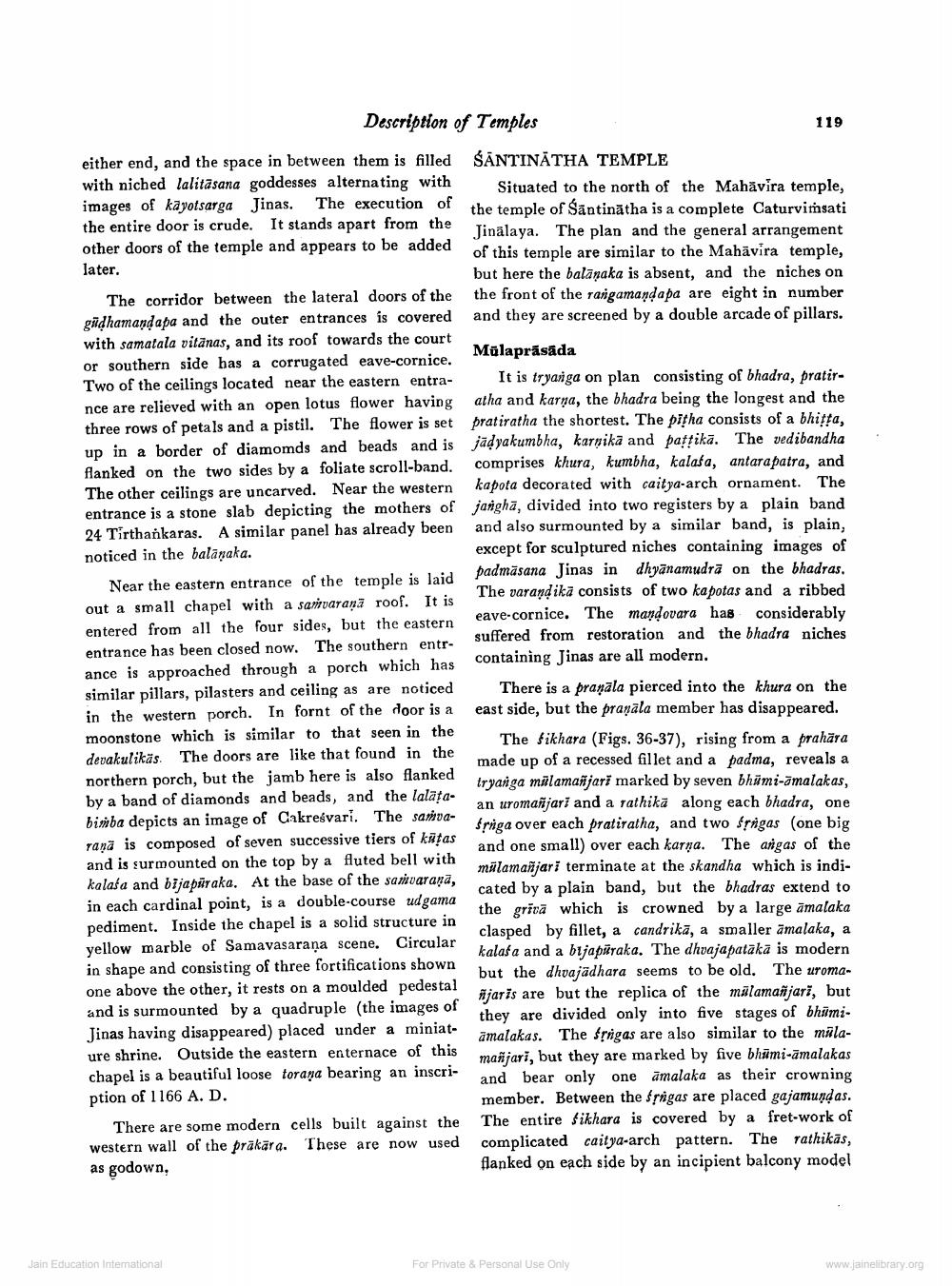________________
Description of Temples
either end, and the space in between them is filled with niched lalitisans goddesses alternating with images of kayotsarga Jinas. The execution of the entire door is crude. It stands apart from the other doors of the temple and appears to be added
later.
The corridor between the lateral doors of the gudhamandapa and the outer entrances is covered with samatala vitanas, and its roof towards the court or southern side has a corrugated eave-cornice. Two of the ceilings located near the eastern entrance are relieved with an open lotus flower having three rows of petals and a pistil. The flower is set up in a border of diamomds and beads and is flanked on the two sides by a foliate scroll-band. The other ceilings are uncarved. Near the western entrance is a stone slab depicting the mothers of 24 Tirthankaras. A similar panel has already been noticed in the balaṇaka.
Near the eastern entrance of the temple is laid out a small chapel with a samvaraṇā roof. It is entered from all the four sides, but the eastern entrance has been closed now. The southern entrance is approached through a porch which has similar pillars, pilasters and ceiling as are noticed in the western porch. In fornt of the door is a moonstone which is similar to that seen in the devakulikäs. The doors are like that found in the
northern porch, but the jamb here is also flanked by a band of diamonds and beads, and the lalața bimba depicts an image of Cakreśvari. The samva rana is composed of seven successive tiers of kitas and is surmounted on the top by a fluted bell with kalata and bijapuraka. At the base of the samvarana, in each cardinal point, is a double-course udgama pediment. Inside the chapel is a solid structure in yellow marble of Samavasarana scene. Circular in shape and consisting of three fortifications shown one above the other, it rests on a moulded pedestal and is surmounted by a quadruple (the images of Jinas having disappeared) placed under a miniat ure shrine. Outside the eastern enternace of this chapel is a beautiful loose torana bearing an inscription of 1166 A. D.
There are some modern cells built against the western wall of the prakara. These are now used as godown,
Jain Education International
119
SANTINĀTHA TEMPLE
Situated to the north of the Mahavira temple, the temple of Santinatha is a complete Caturviṁsati Jinalaya. The plan and the general arrangement of this temple are similar to the Mahavira temple, but here the balaṇaka is absent, and the niches on the front of the rangamandapa are eight in number and they are screened by a double arcade of pillars. Mūlaprāsāda
It is tryanga on plan consisting of bhadra, pratiratha and karna, the bhadra being the longest and the pratiratha the shortest. The pitha consists of a bhiṭṭa, jaḍyakumbha, karnika and paṭṭikā. The vedibandha comprises khura, kumbha, kalasa, antarapatra, and kapota decorated with caitya-arch ornament. The jangha, divided into two registers by a plain band and also surmounted by a similar band, is plain, except for sculptured niches containing images of dhyanamudra on the bhadras. padmasana Jinas in The varaṇḍikā consists of two kapotas and a ribbed eave-cornice. The mandovara has considerably suffered from restoration and the bhadra niches containing Jinas are all modern.
There is a praṇāla pierced into the khura on the east side, but the pranala member has disappeared.
The fikhara (Figs. 36-37), rising from a prahāra made up of a recessed fillet and a padma, reveals a tryanga malamanjari marked by seven bhumi-ōmalakas, an uromañjarī and a rathika along each bhadra, one triga over each pratiratha, and two Srigas (one big and one small) over each karna. The angas of the mulamanjari terminate at the skandha which is indicated by a plain band, but the bhadras extend to the griva which is crowned by a large amalaka clasped by fillet, a candrika, a smaller amalaka, a kalasa and a bijapuraka. The dhvajapatākā is modern but the dhvajadhara seems to be old. The uromajaris are but the replica of the mūlamañjarī, but they are divided only into five stages of bhūmiamalakas. The frigas are also similar to the mulamanjari, but they are marked by five bhimi-amalakas and bear only one amalaka as their crowning member. Between the frigas are placed gajamundas. The entire Sikhara is covered by a fret-work of complicated caitya-arch pattern. The rathikās, Blanked on each side by an incipient balcony model
For Private & Personal Use Only
www.jainelibrary.org




